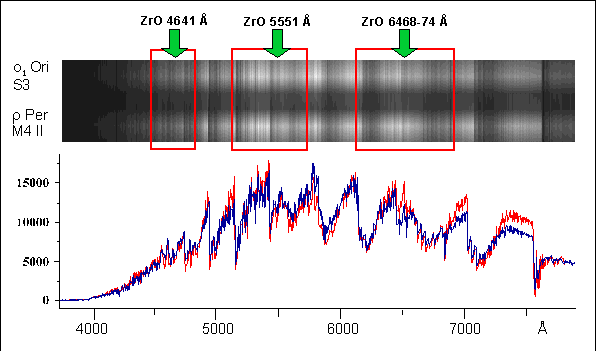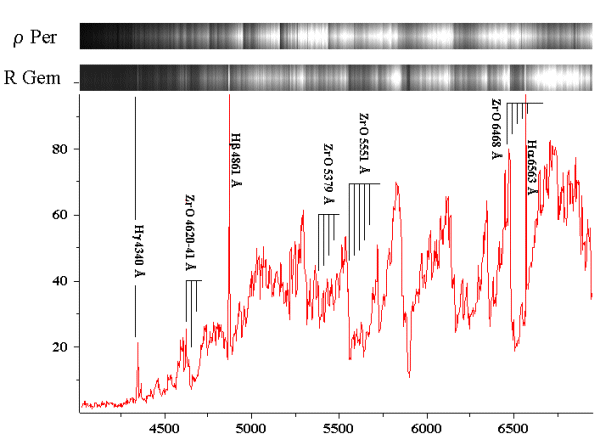PECULIAR STAR SPECTRA
S type stars
The spectra of cold and reddish stars are interrupted by strong molecular absorbtion bands.
Depending on the ratio of oxygen and carbon inside the stellar atmosphere,
the spectra can contain bands from different molecules and thus be very different from case to case.
In "normal" cold stars - those collected in spectral class M - the TiO absorbtions are the strongest.
But when the ratio O/C decrease, then the bands originating from ZrO start to appear because Zirconium, althought less aboundant, has a higher affinity for oxygen. In this case the star become an S star.
If the ratio O/C become even smaller, the metallic oxydes bands disappears and the visible spectrum is filled with C2 bands. These are carbon stars and classified into the N class.
Other molecules that leave their fingerprint in the visible spectrum of all these cold stars are HS, CaH, MgH, SiH, CN.
A band due to MgH can be seen around 4780 ┼ both in the r Per and o1 Ori spectra that are displayed in this page.
Among the brighter S-type stars we can find:
c Cyg (S6/1.5e), T Cam (S6/5e), U Cas (S5/3e), o1 Orionis (S3/1), R Gem (S5/5), R Cyg (S6/6e)

|
Picture 1: Spectrum of Omicron 1 Orionis recorded with 2.5 ┼ spectral resolution and compared with r Persei.
ZrO bands are only slighty visible because o1 Orionis is only S3/1 thus the ratio ZrO/TiO is very low.
At a first glance one can see only the 6468 ┼ band. To see other fainter bands you can look in detail at the recorded spectra selecting one of the
three spectral windows in the picture with your mouse. (Cassegrain 0.6 m F20 telescope, 600 lines/mm grating, camera f=50 mm, CCD MX5 XPress.
Three spectral windows with exposure 2x60 sec each). A much stronger ZrO content is shown in the spectrum of R Geminorum in the picture 2.
|
Classification of S stars uses two parameters. The first number that follows S indicates the temperature, so that an S1/x star has the same temperature as an M1, an S2/x the same of an M2 and so on...
The second number (from 1 to 9) indicates the abundancy of ZrO compared to TiO. When the second number is 1 (example of picture 1) then the ZrO is scarce and its bands are very weak. Increasing numbers indicate more and more ZrO (as is the case of the example of picture 2 of a S5/5 star) and for a value of 9 only ZrO is visible while TiO has completely disappeared. The second number thus give an indication of anomalous chemical abundancies inside the star.
Many S-Type stars are long period variables mainly of Mira type and often they show emission lines due to giant expanding atmospheres. In these cases a suffix "e" is added to the classification. this is the case for R Geminorum whose complete spectral class is thus S5/5e. This star is also a long period variable that reach maximum at 7.1 mag and goes down to 13.2 at minimum.

|
Picture 2: Spectrum of R Geminorum recorded on 20/1/2004 when the star has already passed its maximum of light and was already declining to 8.3 mag. The spectrum, with 2.5 ┼/pixel dispersion is compared with the spectrum of r Persei.
ZrO bands overcome those of TiO. Classification of this star is S5/5e thus the temperature is that of an M5 star. (Cassegrain F20 0.6 m telescope , 600 lines/mm grating, camera f=50 mm, CCD MX5 XPress. Composition of three spectral windows each exposed for 300 sec).
|
Go back to the Home Page of Peculiar Stars
|
|


